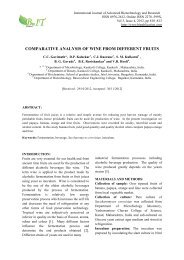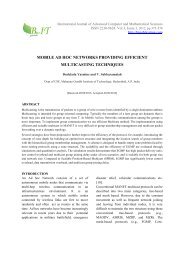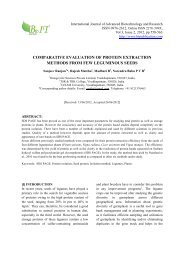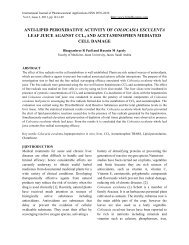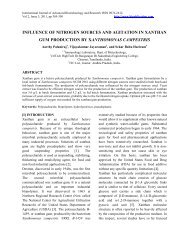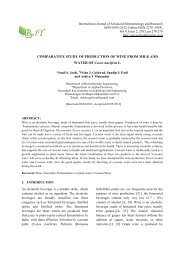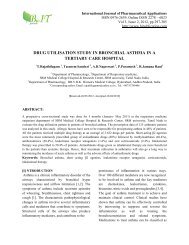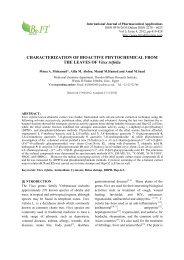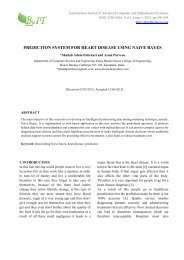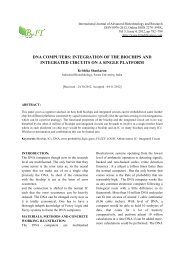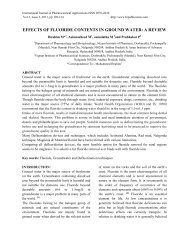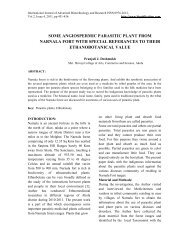375-379 - BioIT international Journals
375-379 - BioIT international Journals
375-379 - BioIT international Journals
You also want an ePaper? Increase the reach of your titles
YUMPU automatically turns print PDFs into web optimized ePapers that Google loves.
International Journal of Pharmaceutical Applications<br />
ISSN 0976-2639.Online ISSN 2278 – 6023<br />
Vol 3, Issue 3, 2012, pp <strong>375</strong>-<strong>379</strong><br />
http://www.bipublication.com<br />
EFFECT OF SYNTHETIC SURFACTANTS ON THE STABILITY OF<br />
PHARMACEUTICAL EMULSIONS<br />
Srinu Naik. S* and K. Anand Kishore<br />
Department of Chemical Engineering, National Institute of Technology,<br />
Warangal-506 004, Andhra Pradesh, India.<br />
*<br />
Corresponding author: Email: srinuchauhan@gmail.com Tel: +91-09885165333<br />
[Received-18/03/2012, Accepted-21/05/12]<br />
ABSTRACT:<br />
Emulsions are commonly used in many major chemical preparations. Certain medicinal agents having an unpleasant<br />
taste and odour can be made more palatable for oral administration in the form of emulsions, which are otherwise<br />
difficult to take. An Emulsion is a liquid preparation containing two immiscible liquids, one of which is dispersed<br />
as minute globule into other, which are made miscible by the addition of a third substance known as surfactants or<br />
emulsifying agent. This work is aimed to investigate the effect of different types of surfactants like Sodium stearate<br />
Glycerol mono stearate, Dioctyl sodium sulfosuccinate and Benzalkonium chloride at various concentrations on the<br />
stability of liquid paraffin and castor oil emulsions. The obtained data are also correlated with the physical<br />
properties of emulsions such as viscosity, surface tension, globule size with temperature and time. The results<br />
suggests that 3% of glycerol mono stearate and 5% dioctyl sodium sulfosuccinate offer high stability within the<br />
temperature range of 30 to 60 0 C and time of 42 days (6 weeks) in the preparation of liquid paraffin emulsions,<br />
where as 3% glycerol mono stearate and 5% sodium stearate in the preparation of castor oil. Surface tension and<br />
globule size are remaining unchanged for the said conditions.<br />
Keywords: Emulsions, Surfactants, Viscosity, Liquid paraffin emulsion<br />
[I] NTRODUCTION<br />
An Emulsion is a liquid preparation containing<br />
two immiscible liquids, one of which is dispersed<br />
as minute globule into other. The liquid that is<br />
broken up into globule is called the dispersed<br />
phase or internal phase and the liquid in which<br />
the globules are dispersed is known as continuous<br />
or external phase. When two immiscible liquids<br />
used to prepare like pharmacy, medicinal<br />
compounds it is very difficult to make them as a<br />
single phase for long period, therefore the third<br />
substance, surfactants are added to the system. A<br />
surface active agent (surfactant) possesses<br />
approximately an equal ratio between the polar<br />
and non-polar portions of each molecule. When<br />
placed in an oil-water system, the polar groups<br />
are attracted to or orient toward the water, and the<br />
non-polar groups are oriented toward the oil. The<br />
surfactant molecules lower the interfacial tension<br />
between the oil and water and form a stable<br />
phase.Surfactants are classified as cationic,<br />
anionic and nonionic based on the type of polar
EFFECT OF SYNTHETIC SURFACTANTS ON THE STABILITY OF PHARMACEUTICAL EMULSIONS<br />
group on the surfactant. Nonionic emulsions are<br />
most popular due to their low toxicity, ability to<br />
be injected directly into the body, and<br />
compatibility with many drug ingredients.<br />
Cationic emulsions are also used in certain<br />
products due to their antimicrobial properties.<br />
A number of investigations are reported in the<br />
literature on the preparation of emulsions using<br />
different surfactants. An extensive review has<br />
been carried out by Laurier L. Schramm et al.,<br />
2003 [1], have reported an overview on the<br />
Surfactants and their applications. Navid Saleh et<br />
al. 2005 [2], directed their investigation on<br />
Trichloroethylene-in-water Pickering emulsions<br />
with greater than 6-month stability were<br />
produced with highly charged PSS brushes<br />
grafted at high density from silica particles. All<br />
emulsions were water-continuous, suggesting that<br />
these particles produce noninvertible emulsions.<br />
These grafted particles were readily dispersed<br />
and colloidally stable in water, so particle<br />
flocculation prior to emulsification played no<br />
role. Muhammad Salman et al. 2008 [3], have<br />
reported the preparation of paraffin and bee wax<br />
emulsion and suggest that stearic<br />
acid/triethanolamine and oleic<br />
acid/triethanolamine are suitable emulsifier and<br />
forms a stable emulsion at room temperature and<br />
can stored at ordinary temperature in any<br />
environment. Shukla Jill B et al. 2010 [4], given<br />
a complete overview of self micro-emulsifying<br />
drug delivery systems (SMEDDS), self micro<br />
emulsifying drug delivery systems are isotropic<br />
mixtures of oil, surfactant, co-surfactant and drug<br />
with a unique ability to form fine oil in water<br />
micro emulsion upon mild agitation. Mostafa<br />
Shahin et al. 2011[5] was determined<br />
experimentally using different methods and<br />
suggested the best non ionic surfactant for the<br />
preparation of jojoba oil, liquid paraffin,<br />
isopropyl myristate with the mixture of span 60<br />
and brij35. The emulsions prepared with a<br />
surfactant blend composed of 3 % w/w span 60<br />
and brij 35 in a ratio of 36:64, 4 % w/w span 60<br />
and brij 35 in a ratio of 52:48 and 5 or 4 % w/w<br />
span 60 and brij 35 in a ratio of 43:57 would<br />
gives a satisfactory stable emulsions of jojoba oil,<br />
liquid paraffin and isopropyl myristate<br />
respectively.<br />
Several studies have been reported for formation<br />
of emulsions using different surfactants with<br />
varying concentration for medical and<br />
pharmaceutical applications, which includes,<br />
investigations on the preparation of multiple<br />
emulsions with Tetronic ® 908 and Abil ® EM90<br />
surfactant [6], preparation of water-in-oil<br />
emulsions using a PTFE<br />
(Polytetrafluoroethylene) [7], rheology and<br />
stabiligy of water-in-oil-in-water multiple<br />
emulsions containing span 83 and tween 80 [8],<br />
preparation of secondary emulsions of fish oil in<br />
water with polymer/emulsion-mixing ratio [9],<br />
preparation and characterization of salbutamol<br />
sulphate loaded ethyl cellulose microspheres<br />
using water-in-oil-emulsion technique [10],<br />
oxidative stability and rheological properties of<br />
oil-in-water emulsions with walnut oil [11] and<br />
water-in-oil and ethanol-in-oil emulsions by<br />
membrane emulsification [12].<br />
[II] MATERIALS AND METHODS<br />
2.1. Materials<br />
Synthetic surfactants, anionic: Sodium<br />
Stearate(SS), Dioctyl Sodium Sulfosuccinate<br />
(DSS), cationic: Benzalkonium Chloride (BC)<br />
and nonionic: Glyceryl Mono Stearate (GMS) are<br />
used to prepare liquid paraffin and castor oil<br />
emulsions with and without additives like<br />
glycerol with benzoic acid as preservative at<br />
different concentrations of 1%, 3%, 5% and 8%<br />
respectively.<br />
2.2. Dry Gum Method (4:2:1)<br />
The Dry gum method is used to prepare the<br />
primary emulsion of liquid paraffin oil, water,<br />
and GMS emulsifier. The primary emulsion is<br />
formed from 4 parts oil, 2 parts water, and 1 part<br />
emulsifier. The 4 parts oil and 1 part emulsifier<br />
represent their total amounts for the final<br />
emulsion. In a mortar, the 1 part GMS with<br />
Srinu Naik. S and K. Anand Kishore 376
EFFECT OF SYNTHETIC SURFACTANTS ON THE STABILITY OF PHARMACEUTICAL EMULSIONS<br />
different concentrations of 1%, 3%, 5% and 8%<br />
respectively was crushed with the 4 parts of<br />
liquid paraffin oil and triturate thoroughly until<br />
the product becomes creamy white and then the 2<br />
parts water are added all at once to form a<br />
primary emulsion and then the additive, glycerol<br />
as added to the primary emulsion and additional<br />
water incorporated to produce the required<br />
volume.<br />
2.3. Wet Gum Method<br />
In this method, the proportions of oil, water, and<br />
emulsifier are the same (4:2:1), but the order and<br />
techniques of mixing are different. The 1 part<br />
surfactant with different concentrations of 1%,<br />
3%, 5% and 8% for SS, DSS and BC is triturated<br />
with 2 parts water to form mucilage; then the 4<br />
parts liquid paraffin oil is added slowly, in<br />
portions, while triturating. After all the oil is<br />
added, the mixture is triturated for several<br />
minutes to form the primary emulsion.<br />
The above methods also carried out for castor oil<br />
emulsion with the same concentrations and for<br />
each samples viscosity, surface tension and<br />
globule size were measured at different<br />
temperatures with 5 0 C intervals from 30 0 C to 60<br />
0 C and also the viscosity of the samples are kept<br />
for observation with a time interval of one week<br />
for a period of one and half month.<br />
2.4. Analytical methods<br />
Viscosity of the samples was measured using<br />
Brooke field viscometer, Interfacial tension with<br />
Tensiometer and the average globule size was<br />
estimated with microscope.<br />
[III] RESULTS AND DISCUSSION<br />
Generally, solubility (the ability to leave its own<br />
and break out of the emulsion) increases as<br />
temperature increases. Once this inversion<br />
begins, the emulsion becomes unstable and<br />
breaks apart. The specific temperature at which<br />
this destabilization takes place is known as the<br />
“phase inversion temperature.” Fig. 1 and Fig. 2<br />
are the comparison of variation in viscosity with<br />
temperature of liquid paraffin emulsion sample<br />
using the GMS and DSS surfactants with 1%,<br />
3%, 5% and 8% concentrations. The samples<br />
were maintained at room temperature (30 0 C),<br />
35 0 C, 40 0 C, 45 0 C, 50 0 C, 55 0 C and 60 0 C. As the<br />
temperature is increase, the momentum of<br />
molecules increases causing an increase in the<br />
kinetic energy of molecules, due to this random<br />
movement occurs which leads to internal<br />
collision, which intern causes agglomeration of<br />
like particles and continuous agglomeration<br />
causes phase separation.<br />
All the samples have shown a decreasing trend<br />
for viscosity as the temperature increased, but the<br />
samples containing 3% Glyceryl mono stearae<br />
and 5% Dioctyl sodium sulfosccinate are good<br />
enough to withstand the increase in temperature.<br />
Fig: 1. Variation in viscosity with temperature at different<br />
concentrations of GMS<br />
Fig. 3 and Fig. 4 represents the comparison of<br />
variation in viscosity with time of liquid paraffin<br />
emulsion using the surfactants GMS and DSS of<br />
1%, 3%, 5% and 8% concentrations. The<br />
samples were maintained for oneday, 1 st week,<br />
2 nd week, 3 rd week, 4 th week, 5 th week and 6 th<br />
week respectively and viscosity was measured for<br />
all samples at room temperature. All the samples<br />
have shown a decreasing trend as time is<br />
progressed, but in the case of BC and SS at all<br />
concentrations the decrease was observed to be<br />
more than either GMS or DSS. Samples<br />
containing 3% GMS and 5% DSS as surfactants<br />
were found to be more viscous and they are able<br />
Srinu Naik. S and K. Anand Kishore 377
EFFECT OF SYNTHETIC SURFACTANTS ON THE STABILITY OF PHARMACEUTICAL EMULSIONS<br />
to retain the viscous nature even the time is<br />
progressed.<br />
Fig: 2. Variation in viscosity with temperature at<br />
different concentrations of DSS<br />
As the time progressed the attraction between<br />
globules tend to oppose the force given by<br />
surfactant, which is responsible for the formation<br />
of emulsion. Therefore beyond a certain time<br />
depending on the strength of the surfactant the<br />
emulsion starts splitting.<br />
Fig. 5 and Fig. 6 have shown the variation of<br />
viscosity with temperature of liquid paraffin<br />
emulsion using the surfactants BC, GMS, DSS<br />
and SS of concentrations 3% and 5%. The<br />
samples containing 3% GMS and 5% DSS are<br />
good enough to withstand even the increase in<br />
temperature, but the samples containing the same<br />
concentrations of BC and SS are shown more<br />
decrease and also separated into two phases in the<br />
range of 50- 55 0 C compare to GMS and DSS.<br />
Fig: 4. Variation in viscosity with time at different<br />
concentrations of DSS<br />
Fig: 5. Comparison in viscosity variation with temperature at<br />
3% concentration of different surfactants<br />
Fig: 3. Variation in viscosity with time at different<br />
concentrations of GMS<br />
Fig: 6. Comparison in viscosity variation with temperature at<br />
5% concentration of different surfactants<br />
Srinu Naik. S and K. Anand Kishore 378
EFFECT OF SYNTHETIC SURFACTANTS ON THE STABILITY OF PHARMACEUTICAL EMULSIONS<br />
[IV] CONCLUSION<br />
The experiments were conducted to test the<br />
stability of liquid paraffin and castor oil<br />
emulsions with different surfactants of Sodium<br />
stearate, Glycerol mono stearate, Dioctyl sodium<br />
sulfosuccinate and Benzalkonium chloride at<br />
various concentrations varying from 1% to 8% in<br />
the temperature range of 30 0 C to 60 0 C and also<br />
viscosity stability was tested on the time interval<br />
of one day to 42 days (6 week). The results<br />
suggests that 3% Glyceryl Mono Stearate and 5%<br />
Dioctyl Sodium Sulfosuccinate offer high<br />
stability within the temperature range of 30 0 C to<br />
60 0 C and time of 42 days in the preparation of<br />
Liquid paraffin emulsions. Surface tension and<br />
globule size are remaining unchanged for above<br />
conditions. Therefore 3% GMS and 5% DSS are<br />
the best surfactants for the preparation of liquid<br />
paraffin emulsions. And also from the<br />
experimental work it was observed that 3% GMS<br />
and 5% SS can be used as surfactants in the<br />
preparation of castor oil emulsions.<br />
REFERENCES<br />
[1]. Laurier L. Schramm, Elaine N. Stasiuk and D.<br />
Gerrard Marangoni, Surfactants and their<br />
applications, Annu. Rep. Prog. Chem., Sect. C, 99<br />
(2003), 3–48.<br />
[2]. Navid Saleh, Traian Sarbu, Kevin Sirk, Gregory<br />
V. Lowry, Krzysztof Matyjaszewski, and Robert<br />
D. Tilton, Oil-in-Water Emulsions Stabilized by<br />
Highly Charged Polyelectrolyte-Grafted Silica<br />
Nanoparticles, Langmuir 2005, 21, 9873-9878.<br />
[3]. Muhammad Salman, Jamil Anwar, Washeed-uz-<br />
Zaman, Muhammad Umar Shafique, Aisha Ifran,<br />
Production of Oil/Water emulsions of paraffin and<br />
bees waxes with water, Journal of Scientific<br />
Research, vol38(2), 2008, 5-8.<br />
O/W emulsions of three different oils,<br />
International Journal of Pharmaceutical Studies<br />
and Research, Vol. II(II), April-June, 2011, 45-51.<br />
[6]. Figen Tirnaksiz, Ozlem Kalsin, A topical w/o/w<br />
multiple emulsions prepared with Tetronic 908 as<br />
a hydrophilic surfactant: Formulation,<br />
characterization and release study , J Pharm<br />
Pharmaceut Sci, 8 (2), 2005, 299-315.<br />
[7]. Naohiro Yamazaki, Kousuke Naganuma,<br />
Masatoshi Nagai, Guang-Hui Ma, and Shinzo<br />
Omi1, Preparation of Water-in-Oil Emulsions<br />
Using a PTFE (Polytetrafluoroethylene)<br />
Membrane—A New Emulsification Device,<br />
Journal of Dispersion science and technology,<br />
Vol. 24 (2), 2003, 249–257.<br />
[8]. Jim Jiao and Diane J. Burgess, Rheology and<br />
Stability of Water-in-Oil-in-Water, Multiple<br />
Emulsions Containing Span 83 and Tween 80 ,<br />
AAPS PharmSci., 5 (1) Article 7, 2003.<br />
[9]. Somprasong Siramard, Luxsana Dubas and<br />
Stephan Thierry Dubas, Method for the<br />
Preparation of Secondary Emulsions of Fish Oil in<br />
Water, Journal of Metals, Materials and Minerals,<br />
Vol.19(1), 2009, 25-28.<br />
[10]. Bipul Natha, Lila Kanta Nath, Bhaskar<br />
Mazumder, Pradeep Kumar, Niraj Sharma and<br />
Bhanu Pratap Sahu, Preparation and<br />
Characterization of Salbutamol Sulphate Loaded<br />
Ethyl Cellulose Microspheres using Water-in-Oil-<br />
Oil Emulsion Technique, Iranian Journal of<br />
Pharmaceutical Research, 9 (2), 2010, 97-105.<br />
[11]. Kremena Nikovska, Oxidative Stability and<br />
Rheological Properties of Oil-In-Water Emulsions<br />
with Walnut Oil, Advance Journal of Food<br />
Science and Technology, 2(3), 2010, 172-177.<br />
[12]. Javier Silvestre de los Reyes, Catherine<br />
Charcosset, Preparation of water-in-oil and<br />
ethanol-in-oil emulsions by membrane<br />
emulsification, Fuel 89, 2010, 3482–3488.<br />
[4]. Shukla Jill B, Koli Akshay R, Ranch Ketan M and<br />
Parikh Rajesh K, Self Micro Emulsifying Drug<br />
Delivery System, International journal of<br />
Pharmaceutical Sciences, vol.1(2), 2010, 13-33.<br />
[5]. Mostafa Shahin, Seham Abdel Hady, Mohammed<br />
Hammad, Nahed Mortada, Development of stable<br />
Srinu Naik. S and K. Anand Kishore <strong>379</strong>



